|
|
 |
| ............................................................. |
|
|
| ........................................................ |
| From
the Editor |

|
Editorial
A. Abyad (Chief Editor) |
|
|
|
|
........................................................ |
Original
Contribution / Clinical Investigation
|



|
<-- Middle East Primary Care Research
Network-->
Frequency
of Job-Related Burn-out in Family Physicians
working in General / Family Practice in the
Middle East
[pdf
version]
Abdulrazak Abyad, Bader Almustafa, Abbas Ali
Mansour, Manal S Al-Mutar, Thamer Al Hilfi,
Seyed Habib Olla Kavari
<-- Saudi Arabia -->
Effect
of Ginger and its Extract on Blood Sugar and
on Kidney Function of Type I Diabetic Rats
[pdf
version]
Abdulsalam, K.A., El gabry, E.K., Alkalifa,
A.S
<-- Saudi Arabia-->
Prevalence of Diabetic Retinopathy among Newly
Diagnosed Type 2 Diabetes Mellitus Patients
in Abha City, Saudi Arabia
[pdf version]
Awad S. Alsamghan, Safar Abadi Al-Saleem, Mohammad
A. Alshibli, Hassan M. Al-Musa
|
........................................................
Medicine and Society
........................................................
Education and Training
|
Chief
Editor -
Abdulrazak
Abyad
MD, MPH, MBA, AGSF, AFCHSE
.........................................................
Editorial
Office -
Abyad Medical Center & Middle East Longevity
Institute
Azmi Street, Abdo Center,
PO BOX 618
Tripoli, Lebanon
Phone: (961) 6-443684
Fax: (961) 6-443685
Email:
aabyad@cyberia.net.lb
.........................................................
Publisher
-
Lesley
Pocock
medi+WORLD International
11 Colston Avenue,
Sherbrooke 3789
AUSTRALIA
Phone: +61 (3) 9005 9847
Fax: +61 (3) 9012 5857
Email:
lesleypocock@mediworld.com.au
.........................................................
Editorial
Enquiries -
abyad@cyberia.net.lb
.........................................................
Advertising
Enquiries -
lesleypocock@mediworld.com.au
.........................................................
While all
efforts have been made to ensure the accuracy
of the information in this journal, opinions
expressed are those of the authors and do not
necessarily reflect the views of The Publishers,
Editor or the Editorial Board. The publishers,
Editor and Editorial Board cannot be held responsible
for errors or any consequences arising from
the use of information contained in this journal;
or the views and opinions expressed. Publication
of any advertisements does not constitute any
endorsement by the Publishers and Editors of
the product advertised.
The contents
of this journal are copyright. Apart from any
fair dealing for purposes of private study,
research, criticism or review, as permitted
under the Australian Copyright Act, no part
of this program may be reproduced without the
permission of the publisher.
|
|
|
| July / August
2016 - Volume 14, Issue 6 |
|
|
Effect of Ginger and
its Extract on Blood Sugar and on Kidney Function
of Type I Diabetic Rats
Abdulsalam,
K.A.
El gabry, E.K.
Alkalifa, A.S
Department of Food Science and Nutrition
College of Food and Agriculture Sciences
King Saud University
Saudi Arabia
Correspondence:
Abdulsalam, K.A.
Department of Food Science and Nutrition
College of Food and Agriculture Sciences
King Saud University
Saudi Arabia
Email: kalabulsalam@gmail.com
|
Abstract
Diabetes
is one of the high-risk diseases; one
of its complications is nephropathy. This
can be reduced by eating some foods. The
goal of this study was to study the effect
of different concentrations of ginger
and its extracts on kidney functions and
glucose in rats (2010-2011) at King Saud
University in Riyadh. Six weeks Wister
Albino rats were divided into six groups
each of ten rats: control group (C) ,
diabetic group (DC), while other groups
were fed by addition of ginger Freeze-dried
or extract concentration (0.5% - 2%) respectively
(DGL, DGH, DGEL, DGEH). Diabetes was induced
by an intraperitoneal injection of streptozotocin
(50 mg/kg of body weight). The results
showed that DGH, DGEL and DGEH groups
had less weight than the two control (C,
DC) groups. The DGEL and DGEH group showed
statistically lowered food intake compared
with the C and DC group. Ginger and its
extracts caused an increase in glucose
level. With regard to nitrogen blood urea
(NBU) and urea, the DGL, DGEL and DGEH
groups had no significant differences
when compared with the C and DC groups.
With regard to creatinine and uric acid
there were no significant differences
among all groups. This study recommends
intake of the low dose of ginger (0.5%)
and the high dose of the ginger extract
(2%) for improvement of the kidney tissue
of diabetic patients.
Key words: diabetes,
rats, ginger, ginger extract,glucose,
kidney function, kidney tissue.
|
Diabetes causes many complications with the
highest kidney failure caused by sorbitol accumulation
in the kidney. The sorbitol is produced by enzyme
aldose reductase and the sorbitol is converted
to fructose by sorbitol dehydrogenase.
This enzyme is absent in the kidney tissue when
the glucose level becomes high and aldose reductase
sufficient so that the sorbitol becomes high
and accumulates in kidney and causes kidney
failure (5).
The high blood glucose in the blood leads to
elevation of sorbitol which is one of the causes
of kidney failure in the diabetic patient. We
have to study some kinds of food like ginger
which might affect kidney function and tissues.
The research goals are: Study the effect of
fresh ginger and its extract (zingeron) on the
body weight and food intake; Study the effect
of fresh ginger and its extract (zingeron) on
the blood sugar in the diabetic rats type one.
Study the effect of fresh ginger and its extract
(zingeron) on the function of kidney and tissue
in type one diabetic rats.
|
MATERIALS AND RESEARCH METHODS |
We used 60 adult rats type Wister albino, average
weight 185 ± 30 g ,divided into two groups.
One control group had ten rats the (C) the other
one had fifty rats injected with streptozotocin
to make them diabetic rat type one (magnitude
50mg/kg by body weight). All experimental procedures
and protocols in this study including euthanasia
were conducted in accordance with the National
Institute of health guide for the care and use
of laboratory animals, Institute for laboratory
animal research (NIH publications No80-23; 1996)
as well as the ethical guidelines of the experimental
animal care center, college of Medicine, King
Saud university, Riyadh, Saudi Arabia. The diabetic
group was divided into five groups, each one
had ten rats. The second diabetic group (DC)
, the third one diabetic and ate 0.5% ginger
in diet (DGL), the fourth one diabetic and ate
2% ginger in diet (DGH), the fifth one diabetic
and ate 0.5% ginger extract (zingeron) in diet
(DGEL), the sixth one diabetic and ate 2% ginger
extract(zingeron) in diet (DGEH). At the end
of the six weeks of experiment the rats were
fasted and anesthetized to pull the blood and
the kidney was saved in formalin to study the
tissues. The glucose was measured by fluorometric
enzymatic analysis (15) and the kidney function
urea by (7) , creatinine (7), uric acid (4).
We used spectrophotometer model Ultrospec 2100
pro from ( Amersham Biosciences, San Francisco,
CA, USA). For the kidney tissues we used Automated
tissue processer by company Lecia model LEICA
TP 1020 from Germany (6). We used statistical
analysis average and standard deviation (means±
SD). We analyzed the transactions to see the
differences between the average measurements
of the transactions and conducted analysis of
variance (One Way ANOVA)and Duncan test using
statistical analysis software(12).
Ingredients of diet (g/1000g for diet)
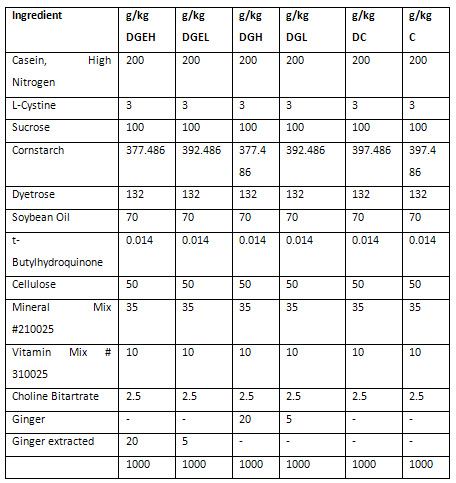
The
result
showed
in
(figure
1)
the
diabetic
control
group
(DC)
showed
no
significant
effect
on
weight
but
in
(DGH,
DGEL,
DGEH)
showed
decrease
in
comparison
with
the
(C,
DC)
groups
(P<0.05).
Our
study
was
inconsistent
with
the
study
(8)
that
showed
lower
weight
in
diabetic
control
rats
and
our
study
agreed
with
(13)
which
showed
it
caused
lower
weight
in
a
group
of
rats
that
ate
ginger
compared
with
the
diabetic
group.
Food
intake
in
(figure
2)
we
see
in
a
groups
(DGEL,
DGEH)
low
in
statistical
analyses
compared
to
the
(C,
DC)
groups
and
our
study
was
inconsistent
with
this
study
(11)
where
there
was
no
significant
difference
in
the
food
intake
in
all
groups.
For
this
study,
the
reason
for
the
low
food
intake
may
return
to
the
diet
because
it
contains
fibre
and
gives
feeling
of
fullness.
The
glucose
in
(figure3)of
the
ginger
and
its
extracts
led
to
a
rise
in
glucose
results
of
this
study
is
inconsistent
to
another
study
(14),
that
found
very
small
amounts
of
ginger
juice
lowered
blood
sugar
significantly
in
control
and
diabetic
rats.
Our
results
agree
with
this
study
(9),
which
explained
that
ginger
leads
to
inhibition
of
the
enzyme
aldose
reductase
and
reduces
the
level
of
sorbitol
and
raises
the
level
of
blood
glucose.
Ginger
and
extract
did
not
affect
all
blood
nitrogen
urea,
urea
and
Uric
acid
(figure
4,
5
and
7),
but
led
to
a
rise
in
creatinine
(figure
6).
Inconsistent
with
our
results
was
a
study
(1)
that
found
giving
ginger
oil
returned
the
kidney
function
to
normal
urea,
uric
acid
and
creatinine.
In
another
study,
the
cause
of
creatinine
rise
was
an
increase
in
demolitions
in
both
the
liver
and
protein
in
blood
giving
glucose
from
non-carbohydrate
sources(2).
Kidney
section
under
the
microscope
showed
tube
and
Glomeruli
(Photo
8.B).
Glomerulus
contains
intermediate
cells
(Photo
8.A).
Group
DGL
and
DGEH
compared
to
control
group
in
glomeruli
tissue
(Photo
10.A)
and
(Photo
A.13)
is
healthy
and
there
is
no
fibrosis
or
inflammatory
activity
in
the
renal
tubules.
Both
groups
showed
some
tubule
atrophy
and
swelling
in
(Photo
B.10)
and
(Photo
B.13).
There
was
found
an
increase
in
the
size
and
number
of
intermediate
cells
in
(CD,
DGH,
DGEL)
in
(Photo
A.9)
,
(Photo
A.11)
and
(Photo
B.12)
and
atrophy
of
the
tubules
and
cellular
fibrosis
(Photo
B.9)
,
(Photo
B.11)
and
(Photo
A.12).
Our
result
is
contrary
to
the
results
of
this
study
(3)
that
found
a
significant
change
among
diabetic
people
in
kidney
tissues
treated
with
ginger.
Our
result
agrees
with
the
study
(10),
where
there
has
been
a
very
simple
change
in
all
groups.
Compare
the
Groups
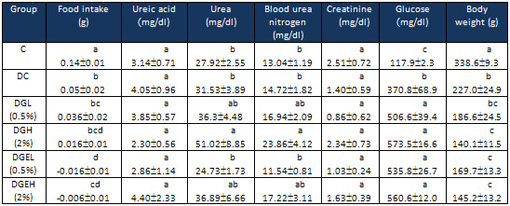 Different
groups
of
rats
during
the
experimental
period.
Data
are
mean
±
SD
values
animals.
Different
letters
are
for
those
significantly
different
from
the
other
groups
of
animals
(P
<.05).
C,
control;
DC,
diabetic
control;
DGL,
diabetic
of
low
ginger
dose;
DGH,
diabetic
of
high
dose;
DGEL,
diabetic
of
low
ginger
extract
dose;
DGEH,
diabetic
of
high
ginger
extract
dose
Different
groups
of
rats
during
the
experimental
period.
Data
are
mean
±
SD
values
animals.
Different
letters
are
for
those
significantly
different
from
the
other
groups
of
animals
(P
<.05).
C,
control;
DC,
diabetic
control;
DGL,
diabetic
of
low
ginger
dose;
DGH,
diabetic
of
high
dose;
DGEL,
diabetic
of
low
ginger
extract
dose;
DGEH,
diabetic
of
high
ginger
extract
dose
Figure
1:
Comparison
of
groups
in
terms
of
weight
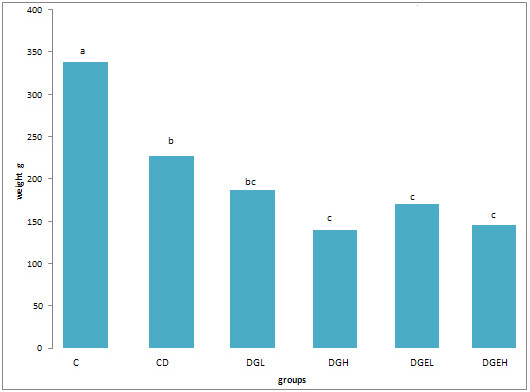
Figure
2:
Comparison
of
groups
in
terms
of
glucose
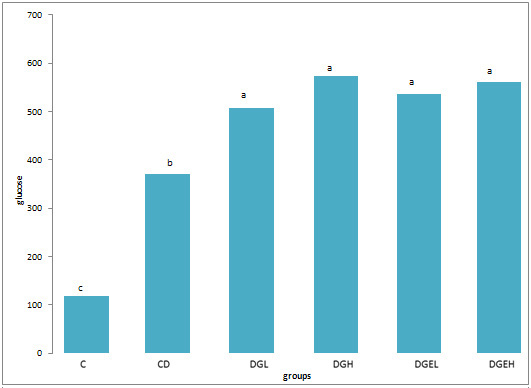
Figure
3:
Comparison
of
groups
in
terms
of
creatinine
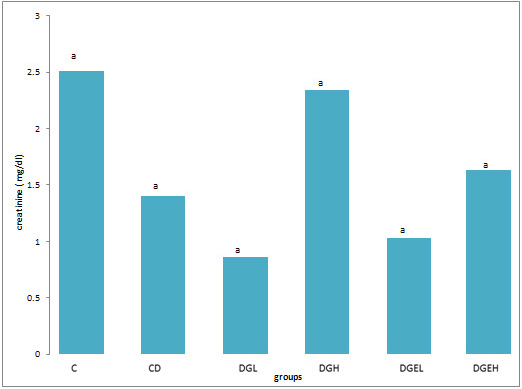
Figure
4:
Comparison
of
groups
in
terms
of
blood
urea
nitrogen
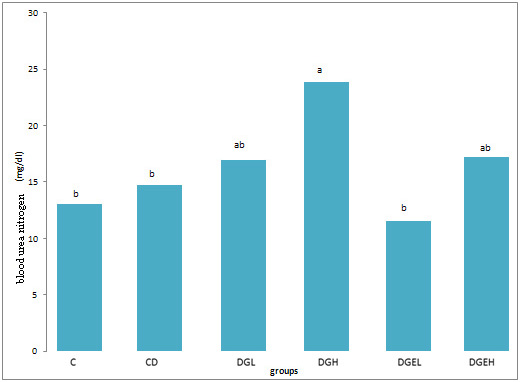
Figure
5:
Comparison
of
groups
in
terms
of
urea
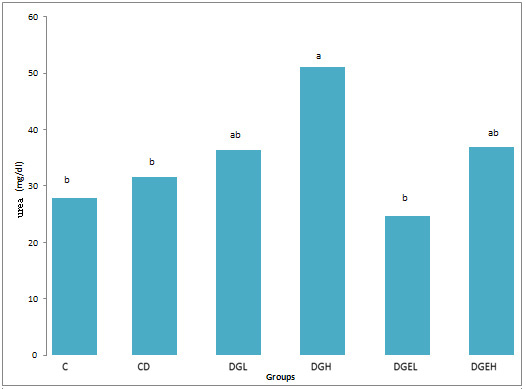
Figure
6:
Comparison
of
groups
in
terms
of
uric
acid
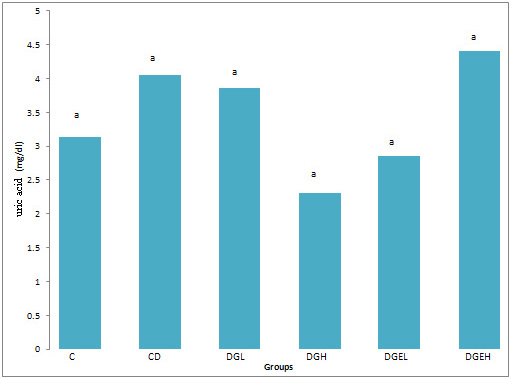
Figure
7:
Comparison
of
groups
in
terms
of
food
intake
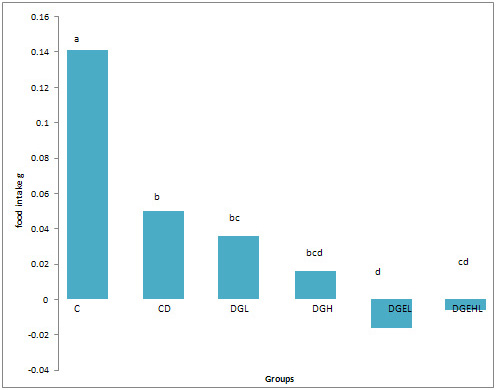
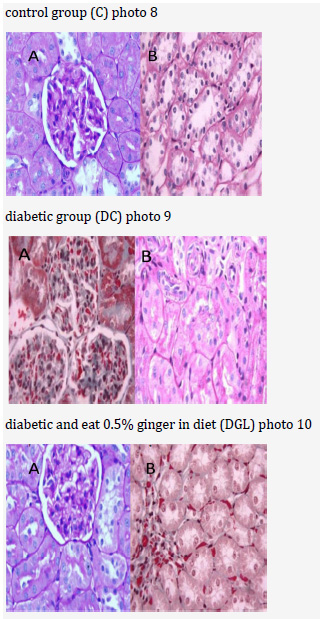
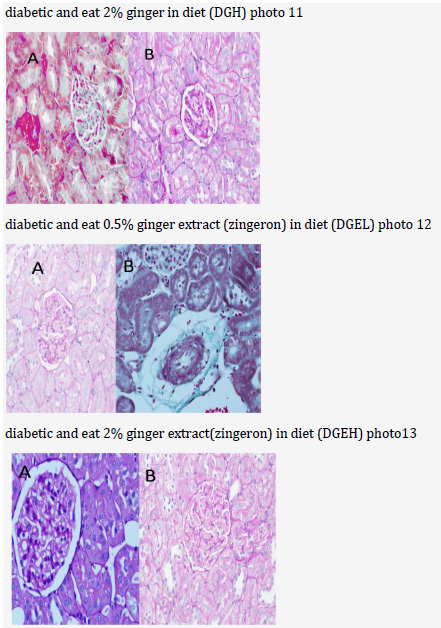
1)
We
recommend
doing
this
study
longer
and
in
different
concentrations
in
extracting:
gingerol,
shogaol,
paradol
and
zingerone
in
human
and
rats.
2)
We
recommend
to
measure
many
things
like
sorbitol,
enzyme
aldose
reductase,
enzymes
of
kidney
and
urea
protein.
Ginger
and
its
extract
did
not
implement
any
change
in
blood
glucose
and
kidney
function
but
the
low
dose
of
ginger
and
the
high
dose
of
ginger
extract
caused
improvement
in
the
tissue
of
the
kidney.
Acknowledgement:
For
the
ladies
who
work
in
Prince
Naif
Bin
AbdulAziz
Health
Research
Center
and
Dr.
Hala
Kafoury
from
Histopathology
in
college
of
medicine
at
King
Saud
University
1)
Al-Attar,
A.M;
Zari,
T.A.
(2007).
Modulatory
effect
of
ginger
clove
oils
on
physiological
responses
in
streptozotocin-induced
diabetic
rats.
Int
J
pharmacology.
3(1):
34-40
2)
Almdal,
T.P.;Vilstrup,
H.(1987).
Effects
of
streptozotocin-induced
diabetes
and
diet
on
nitrogen
loss
from
organs
and
on
the
capacity
of
urea
synthesis
in
rats.
Diabetologia.
30(12):952-6.
3)
Al-Qattan,
K.;
Thmoson,
M.;
Ali,
M.
(2008).
Garlic
(Allium
sativum)
and
ginger
(Ziniber
officinal)
attenuate
structural
nephropathy
progression
in
streptozotocin
-induced
diabetic
rats.
e
-
SPEN.
the
European
e-
J.
ClinNutrandMetabl.
3:e62-e71
4)
Barham,
D.;
Trinder,
P.
(1972).
An
improved
colour
reagent
for
the
determination
of
blood
glucose
by
the
oxidase
system.
97:142-145.
5)
Champe,
P.
A.;
Harvey,
R.
A.;
Ferrier,
D.
R.
(2008).
Biochemistry.
Lippincott's
Williams
and
Wikins.
4th
edition.
United
States
of
America.
New
York.
Pp139-141.
6)
Geoffrey,
G.;
John,
M.
(1974).
An
introduction
to
histotechnology.
Printed
in
the
United
States
of
America.
New
York.
Pp
65.
7)
Henry,
J.
B.;
Todd,
S.
D.
(1974).
Clinical
Diagnosis
and
Management
by
Laboratory
Methods
16th
ed.,
W.B.
Saunders
&
Co.
Philadelphia,
PA.
Pp260,263.
8)
Islam,
M.
S.;
Choi,
H.
(2008).
Comparative
effects
of
dietary
ginger
(Zingiberofficinale)
and
garlic
(Allium
sativum)
investigated
in
type
2
diabetes
model
of
rats.
J
Med
Food.
11(1):152-159.
9)
Kato,
A.;
Higuchi,
Y.;
Goto,
H.;
Kizu,
H.;
Okamoto,
T.;
Asano,
N.;
Hollinshead,
J.;
Nash,
R.
J.;
Adachi,
l.
(2006).Inhibitory
effect
of
Zingiberofficinale
Roscoe
derived
components
on
aldose
reductase
activity
in
vitro
and
in
vivo.
J
Agric
Food
Chem.(54):18:6640-6644.
10)
Lakshmi,
B.
V.
S.;
Sudhakar,
M.
(2010).
Protective
effect
of
Zingiber
officinal
on
gentamicin-
induced
nephrotoxicity
in
rats.
Int
J
Pharmacol.
1-5.
11)
Saraswat,
M.;
Suryanarayana,
P.;
Reddy,
P.
Y.;
Patil,
M.
A.;
Balakrishna,
N
.;
Reddy,
G.
B.
(2010).
Antiglycating
potential
of
Zingiberofficinalis
and
delay
of
diabetic
cataract
in
rats.Molecular
Vision.
16:1531(1525-1537)
12)
SAS.(2009).
SAS
user's
guide:
Statistics
Version
(8.1)
(ed.)
SAS
Institute
Inc.,
Cary,
N.
C.,
USA.
13)
Shanmugam,
K.
R.;
Ramakrishana,
C.
H.;
Mallikarjuna,
K.;
Sathyavelu,
K.
R.
(2009).
The
impact
of
ginger
on
kidney
carbohydrate
metabolic
profiles
in
STZ
induced
diabetic
rats.
Asian
J
EXp
Sci.
1:127-134.
14)
Sharma,
M.;
Shukla,
S.
(1977).
Hypoglycemic
effect
of
ginger.J
Res
Ind
Yoga
Homeop.
12:127-130.
15)
Trinder,
P.
(1969).
Determination
of
blood
glucose
using
4-Aminophenazone.
J
Clin
Path.
(22)246
|
|
.................................................................................................................

|
| |
|

